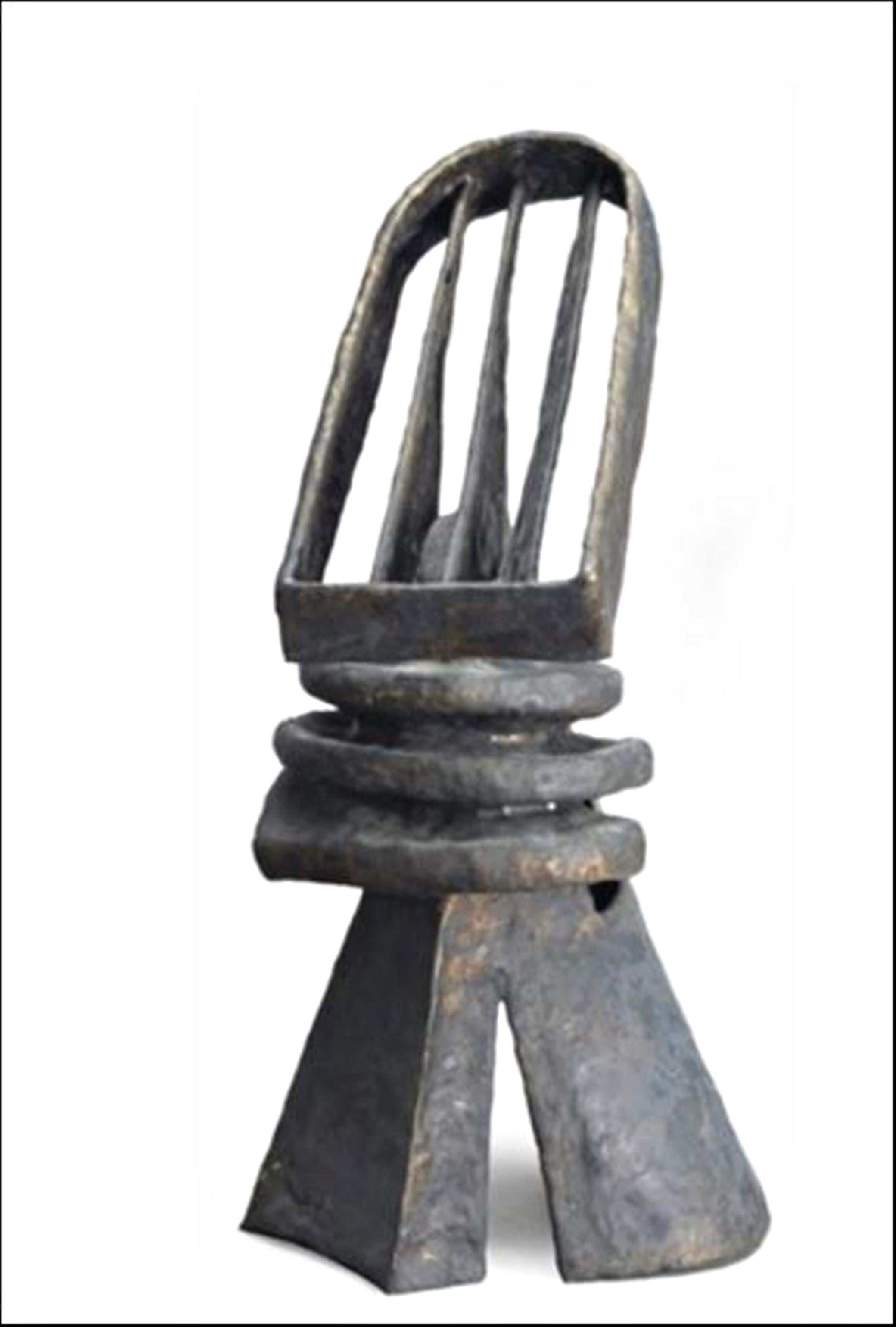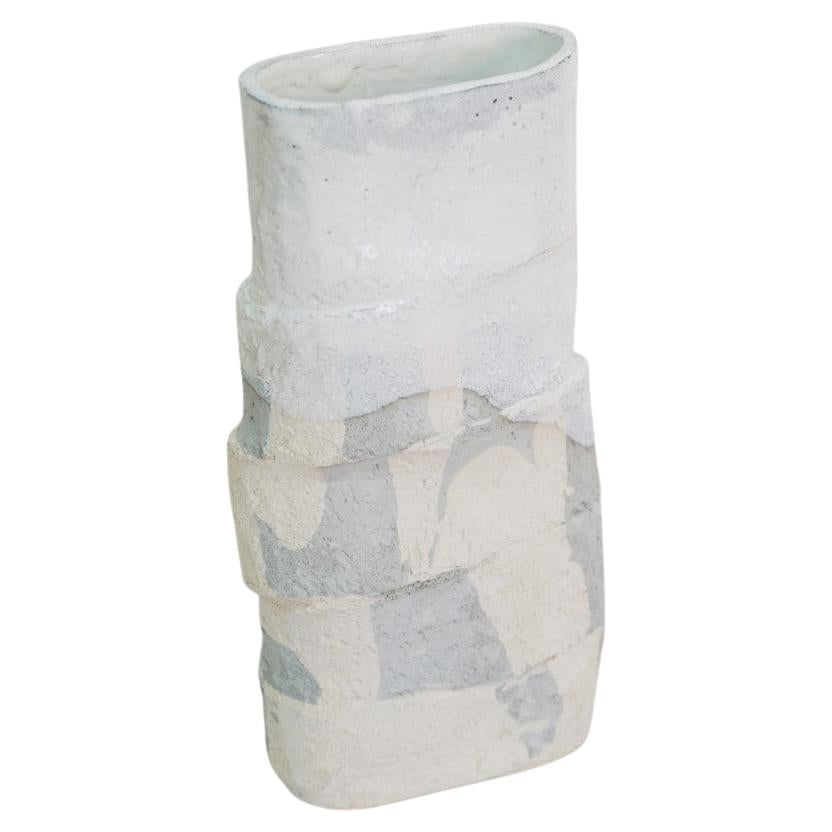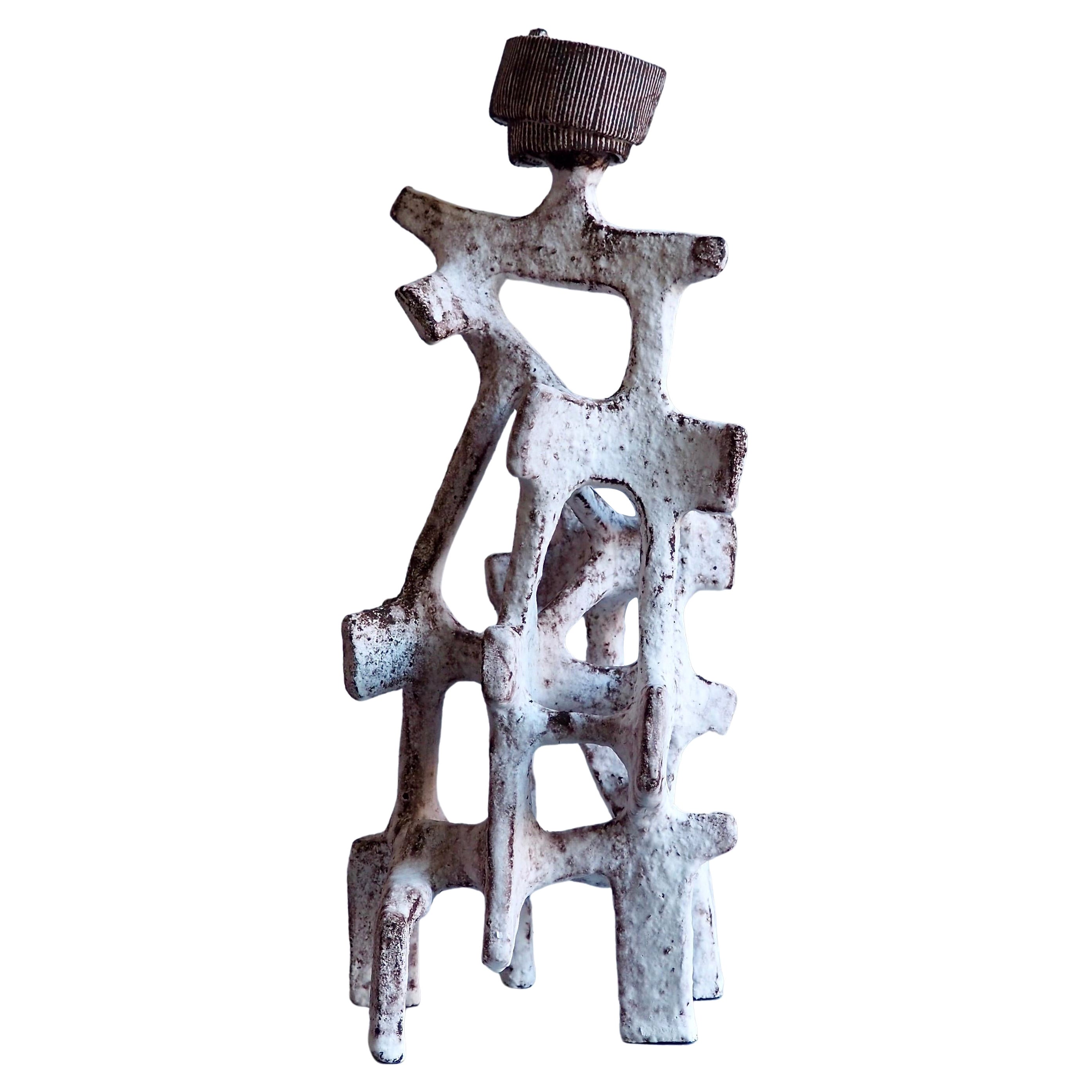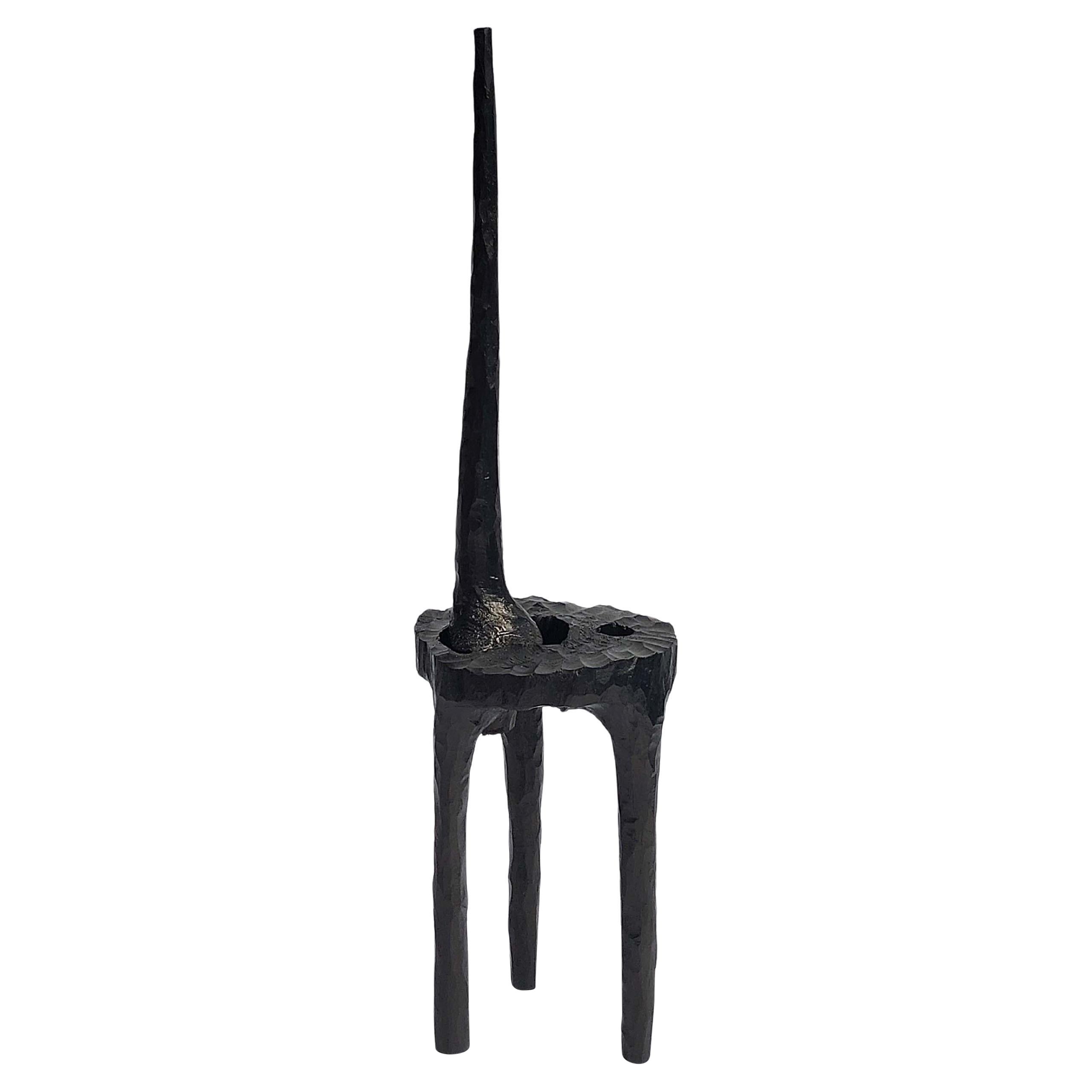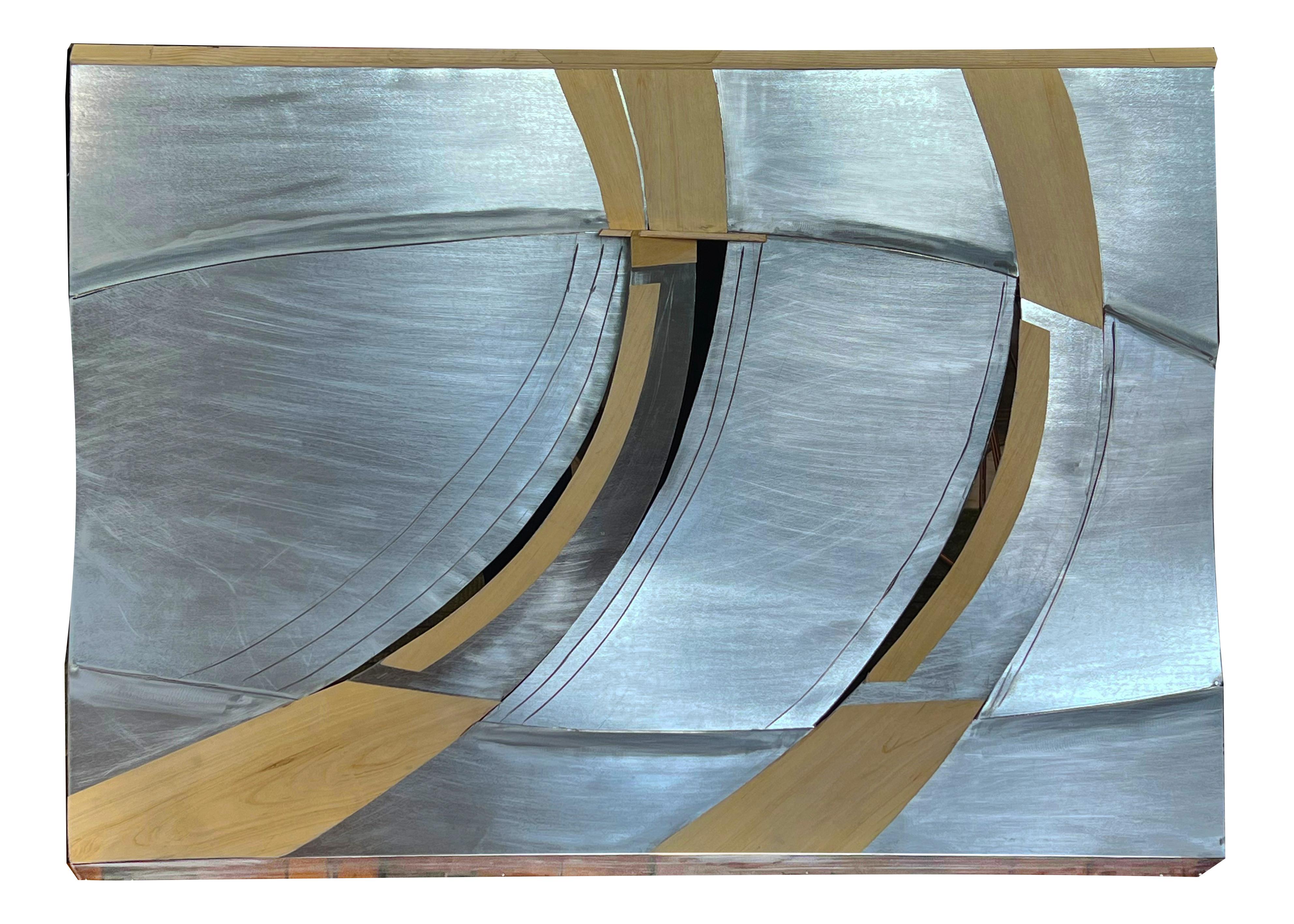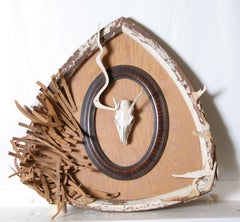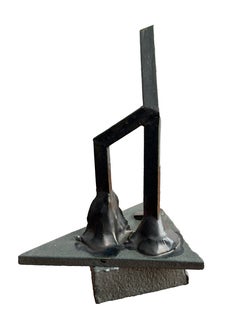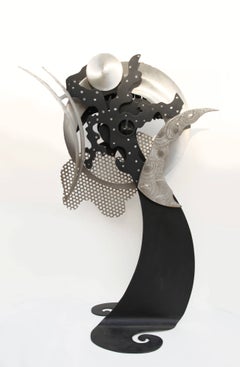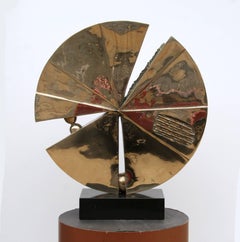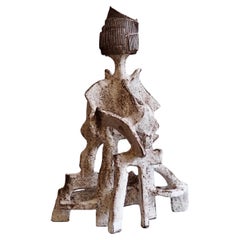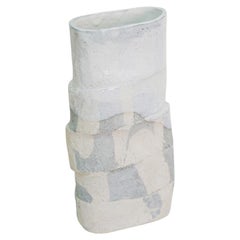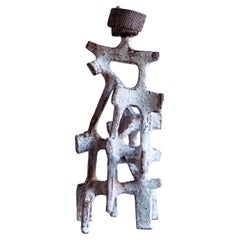Items Similar to Vessel: Pierced III, Unique Wall and Table Art Sculpture by Sylvia Seventy
Want more images or videos?
Request additional images or videos from the seller
1 of 5
Sylvia SeventyVessel: Pierced III, Unique Wall and Table Art Sculpture by Sylvia Seventy1986
1986
$7,000
£5,375.70
€6,160.48
CA$9,854.27
A$11,038.96
CHF 5,752.31
MX$134,652.55
NOK 73,098.61
SEK 68,926.78
DKK 45,980.17
About the Item
This mixed media sculpture by Sylvia Seventy, from 1986, is a conceptual work in neutral tones. Materials include handmade paper, Apple Wood, Willow, Paint, Oil Pastel, Wax, Cotton Card and Glue.
Artist: Sylvia Seventy
Title: Vessel: Pierced III
Year: 1986
Medium: Mixed Media Sculpture
Size: 22 inches diameter x 6 inches tall (55.88 x 15.24 cm)
Handmade paper, Apple Wood, Willow, Paint, Oil Pastel, Wax, Cotton Card and Glue
- Creator:Sylvia Seventy (1947, American)
- Creation Year:1986
- Dimensions:Height: 22 in (55.88 cm)Width: 22 in (55.88 cm)Depth: 6 in (15.24 cm)
- Medium:
- Movement & Style:
- Period:
- Condition:
- Gallery Location:Long Island City, NY
- Reference Number:Seller: RO312321stDibs: LU466266542
About the Seller
4.9
Platinum Seller
Premium sellers with a 4.7+ rating and 24-hour response times
Established in 1979
1stDibs seller since 2014
3,070 sales on 1stDibs
Typical response time: 1 hour
- ShippingRetrieving quote...Shipping from: Long Island City, NY
- Return Policy
Authenticity Guarantee
In the unlikely event there’s an issue with an item’s authenticity, contact us within 1 year for a full refund. DetailsMoney-Back Guarantee
If your item is not as described, is damaged in transit, or does not arrive, contact us within 7 days for a full refund. Details24-Hour Cancellation
You have a 24-hour grace period in which to reconsider your purchase, with no questions asked.Vetted Professional Sellers
Our world-class sellers must adhere to strict standards for service and quality, maintaining the integrity of our listings.Price-Match Guarantee
If you find that a seller listed the same item for a lower price elsewhere, we’ll match it.Trusted Global Delivery
Our best-in-class carrier network provides specialized shipping options worldwide, including custom delivery.More From This Seller
View AllOh, Georgia (Homage to O'Keeffe)
By Carolee Thea
Located in Long Island City, NY
Artist: Carolee Thea
Title: Oh, Georgia (Homage to O'Keeffe)
Year: 1986
Medium: Unique Wall Sculpture: Oak, Varnished Plywood and Bone Construction, signed and dated verso
Size: ...
Category
1980s Surrealist Abstract Sculptures
Materials
Oak, Plywood, Found Objects
Stick in the Mud, Contemporary Ceramic Sculpture by Joe DiStefano
Located in Long Island City, NY
Stick in the Mud
Joe DiStefano, American (1940–2020)
Ceramic
Size: 10.5 x 5 x 6 in. (26.67 x 12.7 x 15.24 cm)
Category
1980s Abstract Abstract Sculptures
Materials
Ceramic
Kinetic Sculpture
By Bruce Stillman
Located in Long Island City, NY
A steel sculpture by Bruce Stillman from 1980. A kinetic sculpture with rotating components perched atop a whimsically modernist base.
Artist: Bruc...
Category
1980s Contemporary Abstract Sculptures
Materials
Steel
Epiphany
By Stefan Matty Vladescu
Located in Long Island City, NY
Artist: Stefan Vladescu, Romanian/American (1952 - )
Title: Epiphany
Year: 1994
Medium: Bronze Sculpture, signature and date inscribed
Size: 25 inch diameter x 1.5 wide
Base 3 x 8...
Category
1990s Surrealist Abstract Sculptures
Materials
Bronze
Another Unrendered Quasi-Articulated Substitution, Wall Sculpture by R. Melee
By Robert Melee
Located in Long Island City, NY
Artist: Robert Melee
Title: Another Unrendered Quasi-Articulated Substitution
Year: 2006
Medium: Beer bottle caps, Plaster and Enamel on Wood, signed verso
Size: 40 inch Diameter
Category
21st Century and Contemporary Abstract Geometric Abstract Paintings
Materials
Enamel
Abstract Unique Papercast by Michael Goldberg 1977
By Michael Goldberg
Located in Long Island City, NY
Artist: Michael Goldberg, American (1924 - 2007)
Title: Untitled II
Year: 1977
Medium: Papercast, signed and dated verso
Size: 25 in. x 29 in. (63.5 cm x 73.66 cm)
Category
1970s Abstract Expressionist Mixed Media
Materials
Handmade Paper
You May Also Like
BG 445 Handcrafed Sculpture by Bronwen Grieves
Located in Geneve, CH
BG 445 Handcrafed Sculpture by Bronwen Grieves
Dimensions: D40 x W28 x H16 cm
Materials: black stoneware white slip.
Other models can be done.
Fired to 1180 c
Bronwen Grieve...
Category
2010s British Post-Modern Abstract Sculptures
Materials
Stoneware
$1,521 / item
Maquette for Laureate (unique sculpture)
By Seymour Lipton
Located in New York, NY
Seymour Lipton
Maquette for Laureate, ca. 1968-1969
Nickel silver on monel metal
Unique
18 × 8 1/2 × 7 inches
Marlborough-Gerson Gallery, New York
Acquired from the above by the previous owner, 1969
thence by descent
Christie's New York: Monday, June 30, 2008 [Lot 00199]
Acquired from the above Christie's sale This unique sculpture by important Abstract Expressionist sculptor Seymour Lipton is a maquette of the monumental sculpture "Laureate" - one of Lipton's most iconic and influential works located on the Riverwalk in downtown Milwaukee, Wisconsin. Laureate is a masterpiece that was commissioned by the Allen-Bradley Company in memory of Harry Lynde Bradley and as an enhancement for the newly constructed Performing Arts Center. It is located on the east bank of the Milwaukee River at 929 North Water Street. The Bradley family in Milwaukee were renowned patrons of modernist sculpture, known for their excellent taste who also founded an eponymous sculpture park. For reference only is an image of the monumental "Laureate" one of Milwaukee's most beloved public sculptures. According to the Smithsonian, which owns a different unique variation of this work, "The full-size sculpture Laureate was commissioned by the Marcus Center for the Performing Arts in Milwaukee. In the initial drawings, Seymour Lipton combined details from the architectural plan with a wide variety of images, ranging from musical instruments to a lighthouse on the island of Tobago. He transformed the basic shapes from these sketches into a welded sculpture, which evokes a figure composed of columns, harp strings, and coiled rope. Lipton created this piece to celebrate achievement in the arts. The dramatic silhouette commands your attention, reflecting the title Laureate, which means worthy of honor and distinction. The final version of the piece is over twelve feet high and stands out against the pale, flat buildings of the arts center.,,"
Provenance
Marlborough-Gerson Gallery, New York
Acquired from the above by the previous owner, 1969
thence by descent
Christie's New York: Monday, June 30, 2008 [Lot 00199]
Acquired from the above Christie's sale
About Seymour Lipton:
Born in New York City in 1903, Seymour Lipton (1903-1986) grew up in a Bronx tenement at a time when much of the borough was still farmland. These rural surroundings enabled Lipton to explore the botanical and animal forms that would later become sources for his work. Lipton’s interest in the dialogue between artistic creation and natural phenomena was nurtured by a supportive family and cultivated through numerous visits to New York’s Museum of Natural History as well as its many botanical gardens and its zoos. In the early 1920s, with the encouragement of his family, Lipton studied electrical engineering at Brooklyn Polytechnic Institute and pursued a liberal arts education at City College. Ultimately, like fellow sculptor Herbert Ferber, Lipton became a dentist, receiving his degree from Columbia University in 1927. In the late 1920s, he began to explore sculpture, creating clay portraits of family members and friends.
In addition to providing him with financial security, dentistry gave Lipton a foundation in working with metal, a material he would later use in his artwork. In the early 1930s, though, Lipton’s primary sculptural medium was wood. Lipton led a comfortable life, but he was also aware of the economic and psychological devastation the Depression had caused New York. In response, he generally worked using direct carving techniques—a form of sculpting where the artist “finds” the sculpture within the wood in the process of carving it and without the use of models and maquettes. The immediacy of this practice enabled Lipton to create a rich, emotional and visual language with which to articulate the desperation of the downtrodden and the unwavering strength of the disenfranchised. In 1935, he exhibited one such early sculpture at the John Reed Club Gallery in New York, and three years later, ACA Gallery mounted Lipton’s first solo show, which featured these social-realist-inspired wooden works. In 1940, this largely self-taught artist began teaching sculpture at the New School for Social Research, a position he held until 1965.
In the 1940s, Lipton began to devote an increasing amount of time to his art, deviating from wood and working with brass, lead, and bronze. Choosing these metals for their visual simplicity, which he believed exemplified the universal heroism of the “everyman,” Lipton could also now explore various forms of abstraction. Lipton’s turn towards increasing abstraction in the 1940s allowed him to fully develop his metaphorical style, which in turn gave him a stronger lexicon for representing the horrors of World War II and questioning the ambiguities of human experience. He began his metal work with cast bronze sculptures, but, in 1946, he started welding sheet metal and lead. Lipton preferred welding because, as direct carving did with wood, this approach allowed “a more direct contact with the metal.”[ii] From this, Lipton developed the technique he would use for the remainder of his career: “He cut sheet metal, manipulated it to the desired shapes, then joined, soldered, or welded the pieces together. Next, he brazed a metal coating to the outside to produce a uniform texture.”[iii]
In 1950, Lipton arrived at his mature style of brazing on Monel metal. He also began to draw extensively, exploring the automatism that abstract expressionist painters were boasting at the time. Like contemporaries such as Jackson Pollock, Lipton was strongly influenced by Carl Jung’s work on the unconscious mind and the regenerative forces of nature. He translated these two-dimensional drawings into three-dimensional maquettes that enabled him to revise his ideas before creating the final sculpture.The forms that Lipton produced during this period were often zoomorphic, exemplifying the tension between the souls of nature and the automatism of the machine.
In the years following the 1950s, Lipton’s optimism began to rise, and the size of his work grew in proportion. The oxyacetylene torch—invented during the Second World War—allowed him to rework the surfaces of metal sculptures, thus eliminating some of the risks involved with producing large-scale finished works. In 1958, Lipton was awarded a solo exhibition at the Venice Biennale and was thus internationally recognized as part of a small group of highly regarded avant-garde constructivist sculptors. In 1960, he received a prestigious Guggenheim Award, which was followed by several prominent public commissions, including his heroic Archangel, currently residing in Lincoln Center’s David Geffen Hall.
A number of important solo exhibitions of his work followed at The Phillips Collection in Washington, DC (1964); the Milwaukee Art Center and University of Wisconsin, Milwaukee (1969); the Virginia Museum of Fine Arts in Richmond (1972); the Everson Museum in Syracuse, NY (1973); the Herbert E. Johnson Museum of Art of Cornell University in Ithaca, NY (1973); the National Collection of Fine Arts, Smithsonian Institution (now the Smithsonian American Art Museum) in Washington, DC (1978); and a retrospective in 1979 at The Jewish Museum in New York. In 1982 and 1984 alone, two exhibitions of his sculpture, organized respectively by the Mint Museum (Charlotte, NC) and the Hillwood Art Gallery of Long Island University (Greenvale, NY), traveled extensively across museums and university galleries around the nation. In 2000, the traveling exhibition An American Sculptor: Seymour Lipton was first presented by the Palmer Museum of Art of Pennsylvania State University in University Park. Most recently, in 2009, the Ackland Art Museum in Chapel Hill, NC mounted The Guardian and the Avant-Garde: Seymour Lipton’s Sentinel II in Context.
Since 2004, Michael Rosenfeld Gallery has been the exclusive representative of the Estate of Seymour Lipton and has presented two solo exhibitions of his work—Seymour Lipton: Abstract Expressionist Sculptor (2005) and Seymour Lipton: Metal (2008). In 2013, Michael Rosenfeld Gallery presented Abstract Expressionism, In Context: Seymour Lipton, which included twelve major sculptures by the artist, along with works by Charles Alston, Norman Bluhm, Beauford Delaney, Willem de Kooning, Jay DeFeo, Michael Goldberg, Adolph Gottlieb, Hans Hofmann, Lee Krasner, Norman Lewis, Conrad Marca-Relli, Boris Margo, Alfonso Ossorio, Richard Pousette-Dart, Milton Resnick, Charles Seliger...
Category
1960s Abstract Expressionist Abstract Sculptures
Materials
Metal, Silver
Unique ÉNOTA_21_09 Sculpture by Emmanuelle Roule
Located in Geneve, CH
Unique ÉNOTA_21_09 Sculpture by Emmanuelle Roule
Unique piece
Dimensions: W 26 x H 55 cm
Materials: stoneware, glaze
Unique piece modelled in fired light g...
Category
2010s French Post-Modern Figurative Sculptures
Materials
Stoneware
$1,560 / item
BG 436 Handcrafed Sculpture by Bronwen Grieves
Located in Geneve, CH
BG 436 handcrafed sculpture by Bronwen Grieves
Dimensions: D40 x W16 x H16 cm
Materials: black stoneware white slip.
Other models can be done.
Fired to 1180 c
Bronwen Griev...
Category
2010s British Post-Modern Abstract Sculptures
Materials
Stoneware
$1,404 / item
Handemade Object #3 by Henry D'ath
Located in Geneve, CH
Handemade object #3 by Henry D'ath
Dimensions: D 15 x H 60 cm
Materials: wood, calligraphy Ink
Piece is handmade by artist.
Henry d’ath is a new zealand born, hong kong based...
Category
2010s Chinese Post-Modern Abstract Sculptures
Materials
Wood
$1,950 / item
0258 Serie Proyectual 15
By Pajaro Gomez
Located in New York, NY
Pájaro Gómez relies on a minimal number of elements to achieve a maximum degree of tension in his glass, stainless steel, and wooden sculptures. Elegant yet dynamic, his sculptures display clean and delicate lines where different components intricately connect with each other and the environment. The result being a juxtaposition of sturdy and fragile, heavy and ethereal objects commanding attention.
Gómez has received numerous awards and has been featured in many solo and collective exhibitions worldwide. He has also become increasingly involved with site-specific projects, recently installing large-scale outdoor sculptures...
Category
2010s Abstract Abstract Sculptures
Materials
Metal
More Ways To Browse
Lemon Vintage Dress
Marc Chagall Serigraph
Maria Callas
Original Vintage Boxing Poster
Painting Indian Horseback
Pink Hunt Slonem Bunnies
Portrait Man Turban
Ron Rice
Salsa Dance
Skateboard Deck Basquiat
Vintage Paris Map Poster
Vintage Poster Braque
Amanda Means
Antique Oil Painting Hunting Large
Arthur Danto
Colonial Africa Poster
Cote De Azur Poster
David Goines

